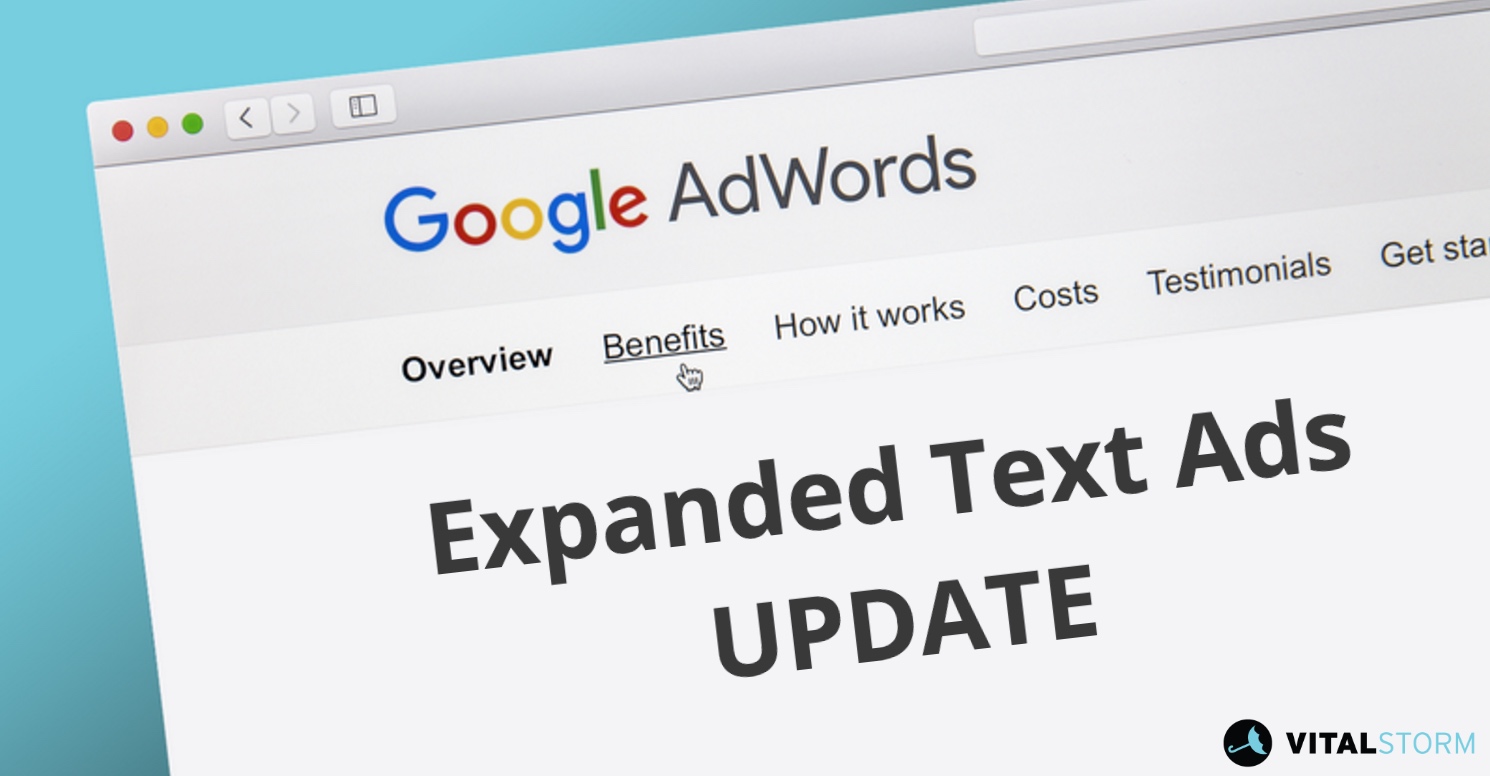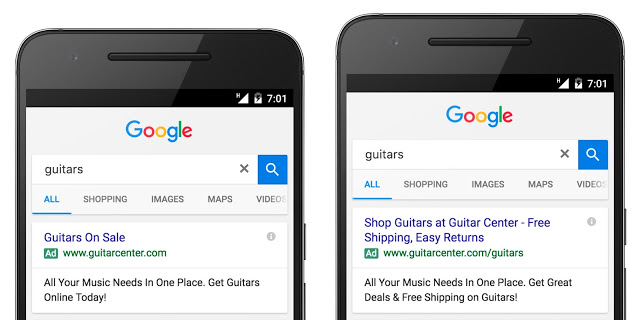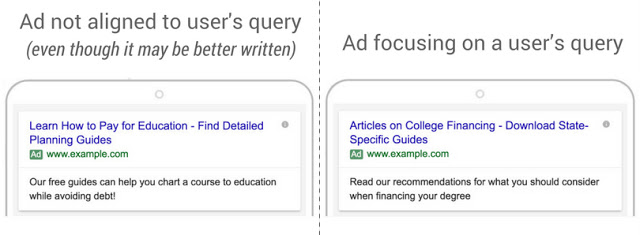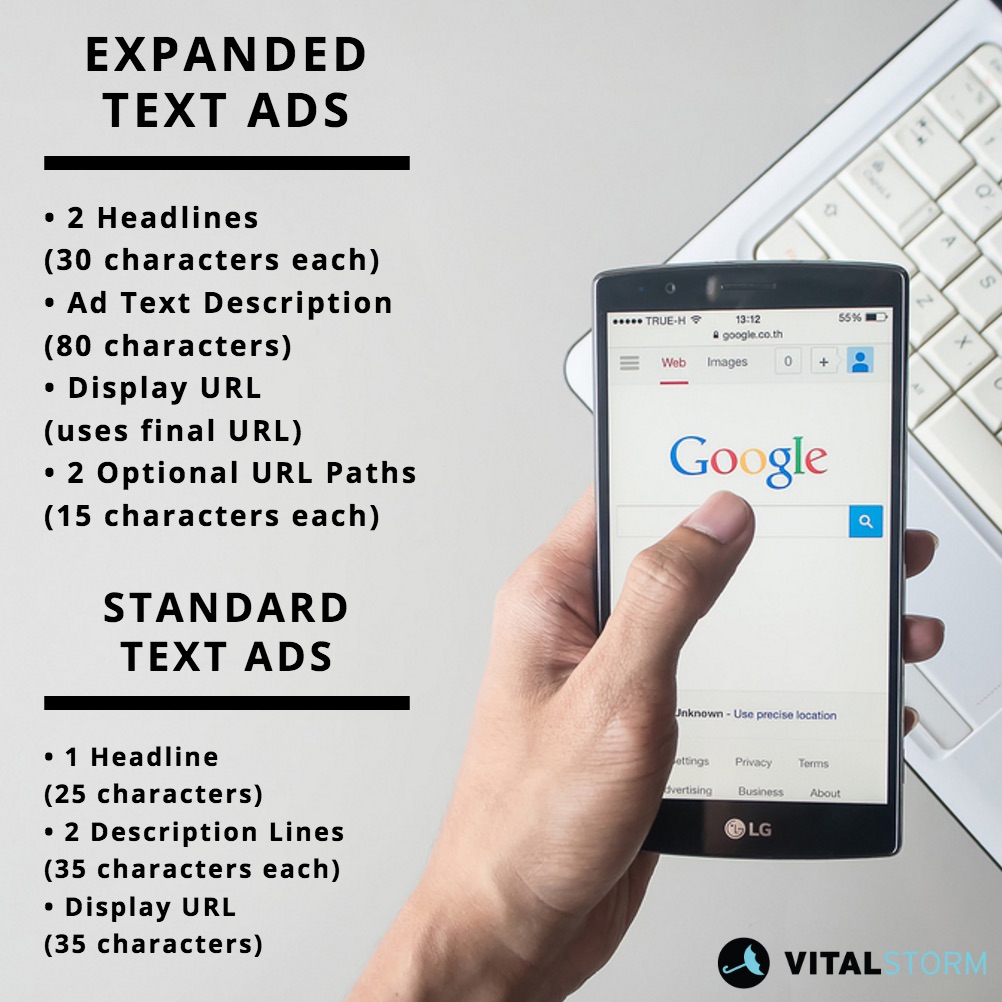Expanded Text Ads (ETA) | Google AdWords and Bing Update 2016

Update your old ads now! Standard Text Ads disappear on January 31, 2017.
Google announced a lot of new updates at its annual Performance Summit in San Francisco earlier this year. There was a lot of focus on mobile (up to about 60% of all search queries), but the most frightening and exciting change was the Google AdWords update of Expanded Text Ads (ETA).
Perhaps Google was already thinking about Expanded Text Ads when they surprised everyone by removing right-side PPC ads in February. Focusing on the PPC ads at the top and bottom of the SERP allowed Google to streamline their ETA update. The new Expanded Text Ads work the same on desktop, mobile, and tablet so your optimized ad text will engage customers on all devices.
Whenever Google makes a big change like this, other search engine advertisers are bound to get on board. Bing Ads understands that most of their advertisers also use Google AdWords, which is why they announced their own Expanded Text Ads update in June. Both search engine giants have argued that this change will positively impact advertisers’ click-through-rates, traffic, and revenue, and we agree.
Before the Expanded Text Ads update, advertisers had the option of creating a “mobile-optimized ad.” Most people ignored this option, failing the see its importance. Now, with just one format, the copy is automatically optimized for different screen sizes.
Why have two different ads anyway? As they say, “keep it simple, stupid.”
What are Expanded Text Ads?
Expanded Text Ads are exactly what they sound like. You now have more real estate (45 additional characters) for your text ads. While Standard Text Ads allowed a total of 95 characters (25-35-35), the new Expanded Text Ads have adopted the 140-character limit made famous by Twitter.
According to Google, “longer ad headlines are more useful to mobile users because they provide additional information about your business before they click your ad.”
You now have two headlines (up to 30 characters each) up from the old one headline (up to 25 characters). This is around 50% more ad text for you to advertise your products and services.
Other important ad text changes include:
- Two headline fields (up to 30 characters each)
- A single, expanded description field (up to 80 characters)
- A display URL that uses your final URL’s domain
- Two optional ”Path” fields, used in the ad’s display URL (up to 15 characters each)
 Source: support.google.com
Source: support.google.com
Standard Text Ads vs Expanded Text Ads
| Expanded Text Ads | Standard Text Ads |
| – 2 Headlines (30 characters each separated by a hyphen) | – 1 Headline (25 characters) |
| – Ad Text Description (80 characters) | – 2 Description Lines (35 characters each) |
| – Display URL (automatically uses final URL) | – Display URL (35 characters) |
| – 2 Optional Paths (15 characters each) |
With Standard Text Ads you were able to choose the display URL, which created more work and potential for error. Now, the display URL is taken from your landing page domain, but you have the option of selecting two customizable “paths.”
For example, if your URL is www.exampleplumberco.com, you can choose a path that tells the user more about your landing page. For drain cleaning queries, you might select www.exampleplumberco.com/Plumbing/Drain-Cleaning. The path has no navigational purpose; it merely provides additional descriptors for the user.
Learn more about Google Standard Text Ads and Expanded Text Ads here.
When do Expanded Text Ads go into effect?
Expanded Text Ads are available now on the Google Search Network, Google Display Network, and all AdWords tools that support text ads. Ad extensions are fully compatible with ETAs.
Now, when you create a new ad, AdWords takes you to the default ETA format. You can switch back to the standard text ad format by clicking on the link above the “Final URL” field, but not for long.
Standard Text Ads are going away for good.
Google has announced:
“Starting January 31, 2017, AdWords will no longer support the creation or editing of Standard Text Ads. New text ads generated after that date should use the expanded text ad format. Existing Standard Text Ads will continue to serve past January 31, 2017.”
Although your standard ads will continue to run past January 31st, you will no longer be able to edit them. This is why you need to rewrite your ad copy NOW!
What does this mean for advertisers?
PPC campaign managers are known for being great with numbers, analytics, and technical details like bidding and keyword matching. Now, things are becoming more automated, which prioritizes creativity and compelling copy. PPC campaign managers have to be effective writers and marketers too!
Reboot Your Old Ads:
- You have until January 31, 2017 to convert all your old ads to the new ETA format.
- Rethink the entire ad creative rather than just adding a second headline.
- Take advantage of the extra space to include additional selling propositions.
- Don’t forget about keyword insertion and ad extensions.
- Test, track, and optimize ads.
- Read Google’s Official Guide to Optimizing Ads and Messaging.
- Speak with your PPC agency about their Expanded Text Ads strategy.
Although not all PPC campaigns will follow the same strategy, it’s probably a good idea to keep your Standard Text Ads running while tracking the success of your new Expanded Text Ads. Testing is still necessary, but be aware that eventually the old ads won’t work anymore. Test multiple ETA strategies and go with the one that converts the best.
Although we haven’t had much time to test the improvements of the new Expanded Text Ads, we’ve already witnessed an upswing in conversions. Learn more about our Expanded Text Ad strategy by giving us a call or shooting over an email.
If you’re not tracking conversions, you’re driving blind.
How to Write a Powerful Headline
On the average, five times as many people read the headline as read the body copy. When you have written your headline, you have spent eighty cents out of your dollar. – David Ogilvy
Your PPC ad text is the first thing prospective leads see. Not only that, it is the main clickable space of the ad. More than ever, the headline is the key factor of your PPC success.
The extra headline included in Expanded Text Ads allows you to say more. The headline will normally take up one line on desktop and two lines on mobile, but they will both always have a dash between them.

Source: adwords.googleblog.com
Don’t think too much about the line break on mobile since “there’s no guarantee where that line will actually break” (Google).
Most people will simply scan the first few words of the headline before deciding to click, read on or scroll down. Your headline should be clear, powerful, and attention grabbing.
You only have a few seconds—choose wisely.
1. Start with value (benefit to the customer)
What are you promising the customer? Ideally, your offer is unique and competitive. Although the offer or benefit will vary across industries, start by imagining what your audience wants. Test your call-to-action placement in the first and second headline to see which works best. Headlines that promise a benefit convert more.
2. Include a keyword (speak directly to the user’s search term)
Use the language of the user in your ad copy. Manage your keywords and copy based on data from your search terms report. It pays to localize your ad by including the name of the region or city in the headline.
Example query: articles about college financing
 Source: adwords.googleblog.com
Source: adwords.googleblog.com
3. Be creative (write compelling, genuine ad copy)
Try to avoid generic sales text like “call today” or “sign up now.” If there is not a real sense of urgency, try not to be too “salesy.” Test all of your promises and benefits to find what works. Replicate your successful Standard Text Ads into the new format.
But be careful not to obfuscate your message with jargon. Your headline should say what you want it to say, in simple language.
4. Test, test, test
Just because you have more space doesn’t necessarily mean you should use it. On average, longer headlines sell better, but test shorter headlines as well. Something as simple as “#1 Dallas Electrician – Need An Electrician Today, Sunday?” might be all you need. Repeat your winners.
How VitalStorm Can Help
- Rewrite your existing ad text
- Approve offers and ad text
- Launch campaign
- Meticulous tracking system (Metrics)
For more Google AdWords advice, follow VitalStorm and AdWords on Twitter and look through the tweets tagged with #AdWordsTips.
If you have any questions about other recent Google or Bing updates, just give us a call or shoot us a message.
- Ads on Google Maps
- Expanded Text Ads
- New Analytics Tools
- Device Bidding
- Responsive Display Ad
- Re-Marketing
Get Qualified Leads Today! Give us a call at 1-877-311-5695.
We follow and report on all the latest PPC and SEO news. Keep in touch with us on Facebook, Twitter, and Google+ for the latest digital marketing news and information.


